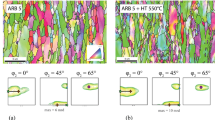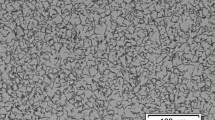Abstract
This study investigates the correlation between coercivity (Hc), grain size (d), and dislocation density in the Permimphy alloy (Fe–80%Ni–6%Mo). The samples used in this study were subjected to varying levels of applied strain through processing by high-pressure torsion. The microstructure and the magnetic coercivity were analyzed using a scanning electron microscope, electron backscatter diffraction and vibrating sample magnetometry. The grain size of the samples varied from 30 to 190 nm. This study demonstrated a strong correlation between Hc and microhardness when d > 3 µm. The results show that the coercivity of the Permimphy alloy follows an inverse V-shape with respect to grain size. The coercivity of the samples decreased despite increasing the dislocation density and the hardness when d < 3 µm. This phenomenon is attributed to the ferromagnetic exchange interaction across multiple grains and leads to the alignment of magnetic moments.










Similar content being viewed by others
Data availability
Some data included in this work are available upon request by contact with the corresponding author.
References
Czichos H, Saito T, Smith LR (2006) Springer handbook of materials measurement methods. Springer, Berlin
Ouyang G, Chen X, Liang Y et al (2019) Review of Fe-6.5 wt%Si high silicon steel—a promising soft magnetic material for sub-kHz application. J Magn Magn Mater 481:234–250. https://doi.org/10.1016/j.jmmm.2019.02.089
Gutfleisch O, Willard MA, Brück E et al (2011) Magnetic materials and devices for the 21st century: stronger, lighter, and more energy efficient. Adv Mater 23:821–842. https://doi.org/10.1002/adma.201002180
Waeckerlé T, Demier A, Godard F, Fraisse H (2020) Evolution and recent developments of 80%Ni permalloys. J Magn Magn Mater 505:166635. https://doi.org/10.1016/j.jmmm.2020.166635
PERMIMPHY is a 80% Nickel soft magnetic alloy. In: Aperam. https://www.aperam.com/product/permimphy-80-nickel/. Accessed 3 Apr 2023
Han L, Maccari F, Souza Filho IR et al (2022) A mechanically strong and ductile soft magnet with extremely low coercivity. Nature 608:310–316. https://doi.org/10.1038/s41586-022-04935-3
Nabi B, Helbert A-L, Brisset F et al (2013) Effect of recrystallization and degree of order on the magnetic and mechanical properties of soft magnetic FeCo–2V alloy. Mater Sci Eng A 578:215–221. https://doi.org/10.1016/j.msea.2013.04.066
Nabi B, Helbert A-L, Brisset F et al (2014) Effect of long range order on mechanical properties of partially recrystallized Fe49Co–2V alloy. Mater Sci Eng A 592:70–76. https://doi.org/10.1016/j.msea.2013.10.093
Herzer G (1989) Grain structure and magnetism of nanocrystalline ferromagnets. IEEE Trans Magn 25:3327–3329. https://doi.org/10.1109/20.42292
Herzer G (1990) Grain size dependence of coercivity and permeability in nanocrystalline ferromagnets. IEEE Trans Magn 26:1397–1402. https://doi.org/10.1109/20.104389
Herzer G (1997) Chapter 3 Nanocrystalline soft magnetic alloys. In: Handbook of Magnetic Materials. Elsevier, pp 415–462
Herzer G (2013) Modern soft magnets: amorphous and nanocrystalline materials. Acta Mater 61:718–734. https://doi.org/10.1016/j.actamat.2012.10.040
Suzuki K, Ito N, Garitaonandia JS et al (2008) Local random magnetocrystalline and macroscopic induced anisotropies in magnetic nanostructures. J Non-Cryst Solids 354:5089–5092. https://doi.org/10.1016/j.jnoncrysol.2008.06.118
Pfeifer F, Radeloff C (1980) Soft magnetic Ni–Fe and Co–Fe alloys—some physical and metallurgical aspects. J Magn Magn Mater 19:190–207. https://doi.org/10.1016/0304-8853(80)90592-2
Zhilyaev AP, Langdon TG (2008) Using high-pressure torsion for metal processing: fundamentals and applications. Prog Mater Sci 53:893–979. https://doi.org/10.1016/j.pmatsci.2008.03.002
Saito Y, Utsunomiya H, Tsuji N, Sakai T (1999) Novel ultra-high straining process for bulk materials—development of the accumulative roll-bonding (ARB) process. Acta Mater 47:579–583. https://doi.org/10.1016/S1359-6454(98)00365-6
Valiev RZ, Langdon TG (2006) Principles of equal-channel angular pressing as a processing tool for grain refinement. Prog Mater Sci 51:881–981. https://doi.org/10.1016/j.pmatsci.2006.02.003
Zhilyaev AP, Kim B-K, Nurislamova GV et al (2002) Orientation imaging microscopy of ultrafine-grained nickel. Scr Mater 46:575–580. https://doi.org/10.1016/S1359-6462(02)00018-0
Zhilyaev AP, Nurislamova GV, Kim B-K et al (2003) Experimental parameters influencing grain refinement and microstructural evolution during high-pressure torsion. Acta Mater 51:753–765. https://doi.org/10.1016/S1359-6454(02)00466-4
Azzeddine H, Bradai D, Baudin T, Langdon TG (2022) Texture evolution in high-pressure torsion processing. Prog Mater Sci 125:100886. https://doi.org/10.1016/j.pmatsci.2021.100886
Wongsa-Ngam J, Kawasaki M, Langdon TG (2013) A comparison of microstructures and mechanical properties in a Cu–Zr alloy processed using different SPD techniques. J Mater Sci 48:4653–4660. https://doi.org/10.1007/s10853-012-7072-0
Figueiredo RB, Pereira PHR, Aguilar MTP et al (2012) Using finite element modeling to examine the temperature distribution in quasi-constrained high-pressure torsion. Acta Mater 60:3190–3198. https://doi.org/10.1016/j.actamat.2012.02.027
Ateba Betanda Y, Helbert A-L, Brisset F et al (2014) Measurement of stored energy in Fe–48%Ni alloys strongly cold-rolled using three approaches: neutron diffraction, Dillamore and KAM approaches. Mater Sci Eng A 614:193–198. https://doi.org/10.1016/j.msea.2014.07.037
Azzeddine H, Tirsatine K, Baudin T et al (2017) On the stored energy evolution after accumulative roll-bonding of invar alloy. Mater Chem Phys 201:408–415. https://doi.org/10.1016/j.matchemphys.2017.08.063
Bate PS, Knutsen RD, Brough I, Humphreys FJ (2005) The characterization of low-angle boundaries by EBSD. J Microsc 220:36–46. https://doi.org/10.1111/j.1365-2818.2005.01513.x
Pippan R, Scheriau S, Taylor A et al (2010) Saturation of fragmentation during severe plastic deformation. Annu Rev Mater Res 40:319–343. https://doi.org/10.1146/annurev-matsci-070909-104445
Rathmayr GB, Pippan R (2011) Influence of impurities and deformation temperature on the saturation microstructure and ductility of HPT-deformed nickel. Acta Mater 59:7228–7240
Renk O, Pippan R (2019) Saturation of grain refinement during severe plastic deformation of single phase materials: reconsiderations, current status and open questions. Mater Trans 60:1270–1282
Tsuji N, Kamikawa N, Li BL (2007) Grain size saturation during severe plastic deformation. In: Materials science forum. Trans Tech Publ, pp 2837–2842
Yu T, Hansen N, Huang X (2011) Recovery by triple junction motion in aluminium deformed to ultrahigh strains. Proc R Soc Math Phys Eng Sci 467:3039–3065. https://doi.org/10.1098/rspa.2011.0097
Yu T, Hansen N, Huang X, Godfrey A (2014) Observation of a new mechanism balancing hardening and softening in metals. Mater Res Lett 2:160–165
Tsuji N (2008) Formation mechanisms of ultrafine grained structures in severe plastic deformation of metallic materials. J Iron Steel Inst Jpn 94:582–589
Humphreys FJ, Hatherly M (2012) Recrystallization and related annealing phenomena. Elsevier
Kawasaki M (2014) Different models of hardness evolution in ultrafine-grained materials processed by high-pressure torsion. J Mater Sci 49:18–34. https://doi.org/10.1007/s10853-013-7687-9
Lee SW, Horita Z (2010) Annealing behavior of FeNi alloy processed by high-pressure torsion. Mater Sci Forum 667–669:313–318. https://doi.org/10.4028/www.scientific.net/MSF.667-669.313
Tirsatine K, Azzeddine H, Huang Y et al (2018) An EBSD analysis of Fe-36%Ni alloy processed by HPT at ambient and a warm temperature. J Alloys Compd 753:46–53. https://doi.org/10.1016/j.jallcom.2018.04.194
Tirsatine K, Azzeddine H, Baudin T et al (2014) Texture and microstructure evolution of Fe–Ni alloy after accumulative roll bonding. J Alloys Compd 610:352–360. https://doi.org/10.1016/j.jallcom.2014.04.173
Bonnot E, Helbert A-L, Brisset F, Baudin T (2013) Microstructure and texture evolution during the ultra grain refinement of the Armco iron deformed by accumulative roll bonding (ARB). Mater Sci Eng A 561:60–66. https://doi.org/10.1016/j.msea.2012.11.017
Boudekhani S, Azzeddine H, Tirsatine K et al (2018) Microstructure, texture, and mechanical properties of Ni-W alloy after accumulative roll bonding. J Mater Eng Perform 27:5561–5570. https://doi.org/10.1007/s11665-018-3628-8
Cullity BD, Graham CD (2011) Introduction to magnetic materials. Wiley
Hosokawa A, Ohtsuka H, Li T et al (2014) Micostructure and magnetic properties in nanostructured Fe and Fe-based intermetallics produced by high-pressure torsion. Mater Trans 55:1286–1291. https://doi.org/10.2320/matertrans.M2014119
Xiang Z, Sun Q, Wang S (2022) Effect of dislocation pattern on the magnetic domain structure of pure polycrystalline Ni. J Mater Res Technol 17:1896–1900. https://doi.org/10.1016/j.jmrt.2022.01.107
Lo CCH, Kinser E, Jiles DC (2003) Modeling the interrelating effects of plastic deformation and stress on magnetic properties of materials. J Appl Phys 93:6626–6628. https://doi.org/10.1063/1.1557356
Dabou O, Bensouilah A, Baudin T et al (2023) Evolution of the texture, microstructure, and magnetic properties of a Permimphy alloy after accumulative roll bonding and aging. J Mater Sci. https://doi.org/10.1007/s10853-023-08994-3
Gabold H, Luan Z, Paul N et al (2018) Structural and magnetic properties of cobalt iron disulfide (CoxFe1−xS2) nanocrystals. Sci Rep 8:4835. https://doi.org/10.1038/s41598-018-22996-1
Acknowledgements
Two of the authors were supported by the European Research Council under Grant Agreement No. 267464-SPDMETALS (YH and TGL).
Author information
Authors and Affiliations
Contributions
Oussama Dabou (M.Sc.) contributed to investigation, validation, writing, and visualization. Thierry Baudin (Dr.) contributed to methodology, review and editing, visualization. François Brisset (Dr.) contributed to methodology and investigation. Thierry Waeckerlé (Dr.) and Yanick Ateba Betanda (Dr.) contributed to methodology and review. Yi Huang (Prof.) contributed to methodology, review and editing. Djamel Bradai (Prof.) and Anne-Laure Helbert (Prof.) contributed to conceptualization, writing, original draft, review and editing, visualization and supervision. Terence G. Langdon (Prof.) contributed to review and editing.
Corresponding author
Ethics declarations
Conflict of interest
The authors declare no competing financial or personal interests concerning the work reported in this manuscript to the best of their knowledge.
Ethical approval
Not applicable.
Additional information
Handling Editor: Megumi Kawasaki.
Publisher's Note
Springer Nature remains neutral with regard to jurisdictional claims in published maps and institutional affiliations.
Rights and permissions
Springer Nature or its licensor (e.g. a society or other partner) holds exclusive rights to this article under a publishing agreement with the author(s) or other rightsholder(s); author self-archiving of the accepted manuscript version of this article is solely governed by the terms of such publishing agreement and applicable law.
About this article
Cite this article
Dabou, O., Baudin, T., Brisset, F. et al. Correlation between microstructure, magnetic properties and mechanical behavior of the Permimphy alloy after high-pressure torsion. J Mater Sci 59, 5968–5980 (2024). https://doi.org/10.1007/s10853-024-09490-y
Received:
Accepted:
Published:
Issue Date:
DOI: https://doi.org/10.1007/s10853-024-09490-y




